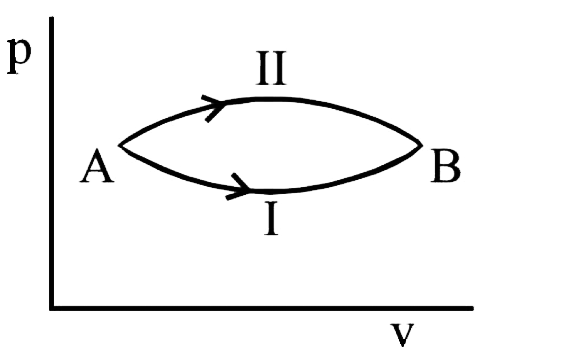If ΔH is the enthalpy change and ΔU the change in internal energy accompanying a gaseous reaction, then
ΔH is always less than ΔU.
ΔH is always than ΔU.
ΔH is less than ΔU if the number of moles of gaseous products is greater than the number of moles of gaseous reactants.
ΔH is less than ΔU if the number of moles of gaseous products is less than the number of moles of gaseous reatants.
To solve the problem, we need to analyze the relationship between the change in enthalpy (ΔH) and the change in internal energy (ΔU) for a gaseous reaction. Here’s a step-by-step breakdown of the solution:
Step 1: Understand the relationship between ΔH and ΔU
The relationship between the change in enthalpy (ΔH) and the change in internal energy (ΔU) can be expressed using the equation:
ΔH=ΔU+PΔV
where P is the pressure and ΔV is the change in volume.
Step 2: Apply the ideal gas law
For an ideal gas, the equation of state is given by:
PV=nRT
where n is the number of moles, R is the universal gas constant, and T is the temperature.
Step 3: Relate ΔV to the change in moles
When a gaseous reaction occurs, the change in volume can be related to the change in the number of moles of gas. The change in moles of gas (ΔNg) is defined as:
ΔNg=nproducts−nreactants
Thus, we can express PΔV in terms of ΔNg:
PΔV=RTΔNg
Step 4: Substitute back into the ΔH equation
Substituting PΔV into the ΔH equation gives:
ΔH=ΔU+RTΔNg
Step 5: Analyze different cases for ΔN_g
1. If ΔNg=0: This means the number of moles of gaseous products equals the number of moles of gaseous reactants. In this case:
ΔH=ΔU
2. If ΔNg>0: This indicates that there are more moles of gaseous products than reactants. Thus:
ΔH=ΔU+RTΔNg(ΔH > ΔU)
3. If ΔNg<0: This means there are fewer moles of gaseous products than reactants. Therefore:
ΔH=ΔU+RTΔNg(ΔH < ΔU)
Conclusion
From the analysis, we conclude:
- If ΔNg=0, then ΔH=ΔU.
- If ΔNg>0, then ΔH>ΔU.
- If ΔNg<0, then ΔH<ΔU.
Thus, the relationship between ΔH and ΔU depends on the change in the number of moles of gaseous products and reactants.
The relationship between the change in enthalpy (ΔH) and the change in internal energy (ΔU) can be expressed using the equation:
ΔH=ΔU+PΔV
where P is the pressure and ΔV is the change in volume.
For an ideal gas, the equation of state is given by:
PV=nRT
where n is the number of moles, R is the universal gas constant, and T is the temperature.
When a gaseous reaction occurs, the change in volume can be related to the change in the number of moles of gas. The change in moles of gas (ΔNg) is defined as:
ΔNg=nproducts−nreactants
Thus, we can express PΔV in terms of ΔNg:
PΔV=RTΔNg
Substituting PΔV into the ΔH equation gives:
ΔH=ΔU+RTΔNg
1. If ΔNg=0: This means the number of moles of gaseous products equals the number of moles of gaseous reactants. In this case:
ΔH=ΔU
ΔH=ΔU+RTΔNg(ΔH > ΔU)
ΔH=ΔU+RTΔNg(ΔH < ΔU)
From the analysis, we conclude:
- If ΔNg=0, then ΔH=ΔU.
- If ΔNg>0, then ΔH>ΔU.
- If ΔNg<0, then ΔH<ΔU.
Topper's Solved these Questions
- THERMODYNAMICSBOOK - CENGAGE CHEMISTRY ENGLISHCHAPTER - THERMODYNAMICSEXERCISE - Exercise
1 Videos
- THERMODYNAMICSBOOK - CENGAGE CHEMISTRY ENGLISHCHAPTER - THERMODYNAMICSEXERCISE - Ex 6.1
26 Videos
- STOICHIOMETRYBOOK - CENGAGE CHEMISTRY ENGLISHCHAPTER - STOICHIOMETRYEXERCISE - Archives Subjective
33 Videos
Similar Questions
If ΔH is the change in enthylpy and ΔU, the change in internal energy accompanying a gaseous reactant then
View SolutionThe change in the internal energy of a substance
View SolutionA mixture of 2 moles of CO and 1 mole of O2, in a closed vessele is ignited to convert the CO to CO2 if ΔH is the enthalpy change and ΔU is the change in internal energy then:
View SolutionEnthalpy change equal internal energy change when
View SolutionWhy is the enthalpy considered more useful than internal energy in chemical reactions ?
View SolutionThe enthalpy change of a reaction does not depend on
View SolutionChange in internal energy in an isothermal process for ideal gas is
View SolutionIn a reversible isothermal process, the change in internal energy is :
View SolutionThe magnitude of ethalphy changes for reversible adiabatic expansion of a gas from volume V1 to V2(in L)is ΔH1 and for irreversible adiabatic expansion for the same expansion is ΔH2. Then
when ΔU1 and ΔU2 are the changes in magnitudes for the internal energy of gas in the two expansions.
View SolutionA system goes from A and B via two processes. I and II as shown in figure. If ΔU1andΔU2 are the changes in internal energies in the processes I and II respectively, then

View Solution
